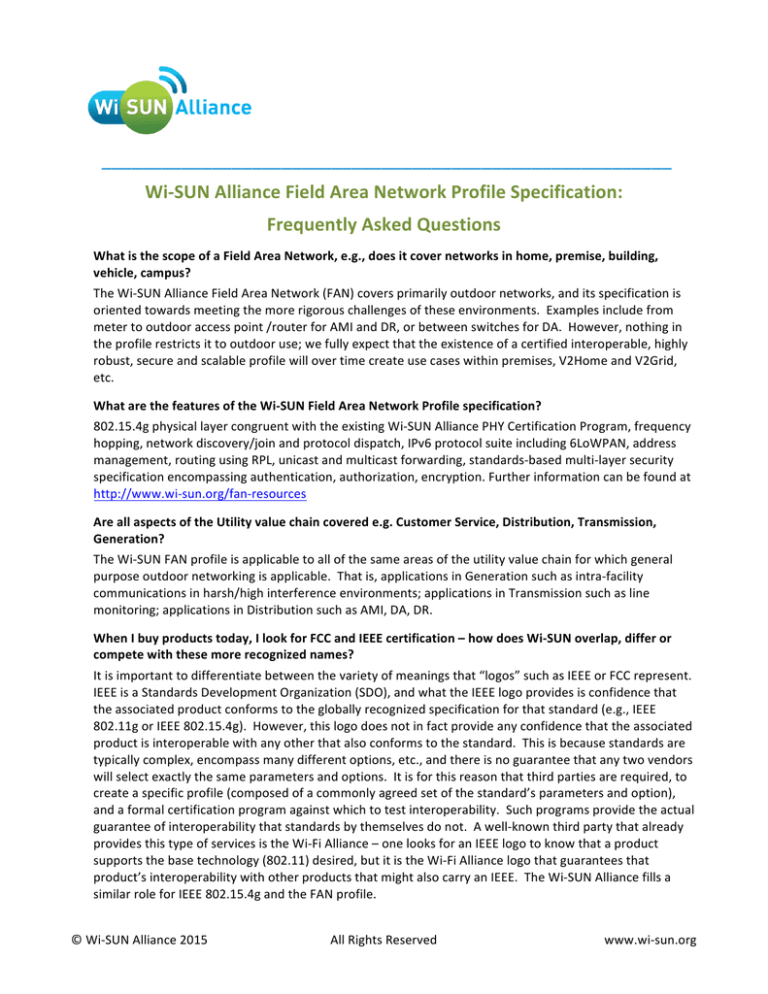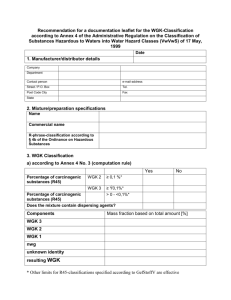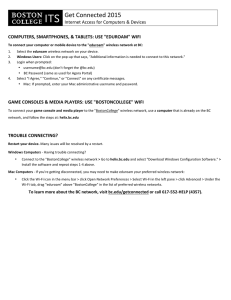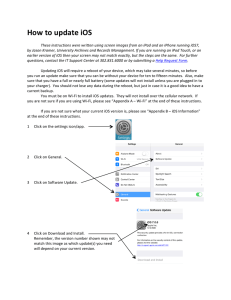
_________________________________________________________ Wi-­‐SUN Alliance Field Area Network Profile Specification: Frequently Asked Questions What is the scope of a Field Area Network, e.g., does it cover networks in home, premise, building, vehicle, campus? The Wi-­‐SUN Alliance Field Area Network (FAN) covers primarily outdoor networks, and its specification is oriented towards meeting the more rigorous challenges of these environments. Examples include from meter to outdoor access point /router for AMI and DR, or between switches for DA. However, nothing in the profile restricts it to outdoor use; we fully expect that the existence of a certified interoperable, highly robust, secure and scalable profile will over time create use cases within premises, V2Home and V2Grid, etc. What are the features of the Wi-­‐SUN Field Area Network Profile specification? 802.15.4g physical layer congruent with the existing Wi-­‐SUN Alliance PHY Certification Program, frequency hopping, network discovery/join and protocol dispatch, IPv6 protocol suite including 6LoWPAN, address management, routing using RPL, unicast and multicast forwarding, standards-­‐based multi-­‐layer security specification encompassing authentication, authorization, encryption. Further information can be found at http://www.wi-­‐sun.org/fan-­‐resources Are all aspects of the Utility value chain covered e.g. Customer Service, Distribution, Transmission, Generation? The Wi-­‐SUN FAN profile is applicable to all of the same areas of the utility value chain for which general purpose outdoor networking is applicable. That is, applications in Generation such as intra-­‐facility communications in harsh/high interference environments; applications in Transmission such as line monitoring; applications in Distribution such as AMI, DA, DR. When I buy products today, I look for FCC and IEEE certification – how does Wi-­‐SUN overlap, differ or compete with these more recognized names? It is important to differentiate between the variety of meanings that “logos” such as IEEE or FCC represent. IEEE is a Standards Development Organization (SDO), and what the IEEE logo provides is confidence that the associated product conforms to the globally recognized specification for that standard (e.g., IEEE 802.11g or IEEE 802.15.4g). However, this logo does not in fact provide any confidence that the associated product is interoperable with any other that also conforms to the standard. This is because standards are typically complex, encompass many different options, etc., and there is no guarantee that any two vendors will select exactly the same parameters and options. It is for this reason that third parties are required, to create a specific profile (composed of a commonly agreed set of the standard’s parameters and option), and a formal certification program against which to test interoperability. Such programs provide the actual guarantee of interoperability that standards by themselves do not. A well-­‐known third party that already provides this type of services is the Wi-­‐Fi Alliance – one looks for an IEEE logo to know that a product supports the base technology (802.11) desired, but it is the Wi-­‐Fi Alliance logo that guarantees that product’s interoperability with other products that might also carry an IEEE. The Wi-­‐SUN Alliance fills a similar role for IEEE 802.15.4g and the FAN profile. © Wi-­‐SUN Alliance 2015 All Rights Reserved www.wi-­‐sun.org I buy network solutions from public carriers – will they be members? Yes, Wi-­‐SUN Alliance encourages public carriers as members. Utility networks often include Wireless Mesh and Cellular technologies and Wi-­‐SUN Alliance works to identify and define heterogenous network topologies. What is the certification program expected to do, will vendors we purchase products from conduct a formal test, and how will this be different from the SGIP 2.0 programs and other Alliances? The certification program requires that products are submitted to an Independent Test Laboratory where a formal test procedure validates that they are conformant to the required communications standards and that they interoperate with other similar, proven products. The vendor emerges from this formal program with the right to affix the Wi-­‐SUN Alliance logo to their product(s), and this logo in turn provides the customer confidence that the vendor has passed the formal certification process. This is, as described above, similar to other Alliances such as Wi-­‐Fi, but focused on the standards of interest to operators of large-­‐scale outdoor infrastructure such as utilities, municipalities, etc. As a Utility, we invest in final products from multiple vendors – how will I know these vendors have passed certification? All certified products are listed on the Wi-­‐SUN Alliance website and the Product Vendor is issued with a Product Certificate. Additionally, products will be entitled to carry the Wi-­‐SUN Alliance Logo. How will this program help my company reduce time and cost of deploying new solutions? Wi-­‐SUN Alliance certifies products based on their compliance to applicable standards and their ability to interoperate with other Wi-­‐SUN certified products. This reduces the time needed to evaluate new products, as behavior, performance and interoperability are well defined and well understood; it reduces the time and cost of custom integrations required in a non-­‐interoperable world; it lowers overall costs, and/or increases the pace of feature/function improvement, by eliminating single-­‐vendor proprietary lock-­‐
in, and thus increasing competition. How do you plan to test cyber security related challenges? Wi-­‐SUN Alliance profiles use proven, standards-­‐based cyber security methodologies and transport protocols. Testing these aspects of cyber security (i.e., product implementations as specified in existing standards) is within the scope of the Wi-­‐SUN certification program, and certified product therefore provides that assurance. However, cyber security additionally depends on a larger environment of configuration control, policies, and procedures. These are outside the scope of the Wi-­‐SUN Alliance, and will continue to be tested using existing processes between customer and vendor (i.e., available security test tools, 3rd party penetration testing, etc.) How often will I have to attend face to face meetings? Wi-­‐SUN Alliance holds 2 face to face meetings per year. Members are encouraged to attend, but there is absolutely no obligation to attend (attendance is not required in order to preserve rights, etc.) I have already deployed my AMI and Distribution Automation networks – will these be recertified by vendors that join the Alliance? Great care was taken during the definition of IEEE 802.15.4g to ensure that many, if not most, existing AMI and Distribution Automation networks would be possible to make interoperable with the standard via only over the air upgrades, and not hardware replacement. It is, however, the responsibility of the vendors to create a compliant (certified) implementation, and to support such an over the air upgrade to achieve compliance. So, both the IEEE standard and the Wi-­‐SUN certification program are explicitly designed to support upgrades of deployed systems to certified profiles; whether in practice this is achieved for any given customer will depend on the vendors, products, and ongoing support they have selected. For further information, please email info@wi-­‐sun.org © Wi-­‐SUN Alliance 2015 All Rights Reserved www.wi-­‐sun.org



